Article
Tanshinone IIA inhibits human gastric carcinoma AGS cell growth by decreasing BiP, TCTP, Mcl‑1 and Bcl‑xL and increasing Bax and CHOP protein expression
- Authors:
-
View Affiliations / Copyright
Affiliations:
Tumor Research Center of Integrative Medicine, Comprehensive Breast Cancer Center, Changhua Christian Hospital, Changhua 50006, Taiwan, R.O.C.
-
Pages:
1661-1668
|
Published online on:
September 29, 2014
https://doi.org/10.3892/ijmm.2014.1949
- Expand metrics +
Metrics:
Total
Views: 0
(Spandidos Publications: | PMC Statistics:
)
Metrics:
Total PDF Downloads: 0
(Spandidos Publications: | PMC Statistics:
)
This article is mentioned in:
Abstract
Tanshinone IIA (Tan‑IIA) is extracted from Danshen (Salviae Miltiorrhizae Radix) and is a natural anti‑cancer agent, which possesses antitumor activity in a variety of human cancer cells. Tan‑IIA can induce apoptosis and inhibit the proliferation of gastric cancer through different molecular mechanisms. However, the efficacy and molecular mechanism of Tan‑IIA in gastric cancer have not been well studied. In the present study, the cytotoxicity of Tan‑IIA in human gastric cancer AGS cells by 3‑(4,5‑dimethylthiazol‑2‑y1)‑2,5‑diphenyltetrazolium bromide assay was examined. The protein expression levels of B‑cell lymphoma‑extra large (Bcl‑xL), Bcl‑2‑associated X protein (Bax), myeloid cell leukemia 1 protein (Mcl‑1), translationally‑controlled tumor protein (TCTP), binding immunoglobulin protein (BiP), calnexin, protein kinase-like endoplasmic reticulum kinase, eIF2α, activating transcription factor 4 (ATF4), inositol‑requiring enzyme 1α (IRE1α), ATF6, caspase‑12, caspase‑9, caspase‑3, C/EBP‑homologous protein (CHOP) and β‑actin in AGS cells were measured by western blot analysis. The results showed that Tan‑IIA inhibited AGS cells in a time‑and dose‑dependent manner. AGS cells treated with Tan‑IIA upregulated the protein expression of caspase‑12, caspase‑9, caspase‑3, CHOP and Bax, but downregulated the protein expression of BiP, TCTP, Mcl‑1 and Bcl‑xL. These findings indicated that Tan‑IIA inhibits the growth of human gastric cancer AGS cells. One of the molecular mechanisms may be through decreasing the protein expression of BiP to induce the activation of endoplasmic reticulum stress, followed by increasing the protein expression of caspase‑12 to upregulate CHOP expression. The other may be through decreasing the protein expression of Mcl‑1, Bcl‑xL and TCTP, but increasing Bax, caspase‑9 and caspase‑3 to induce apoptosis. The chemotherapeutic potential of Tan‑IIA for human gastric cancer warrants further study in the future.
View Figures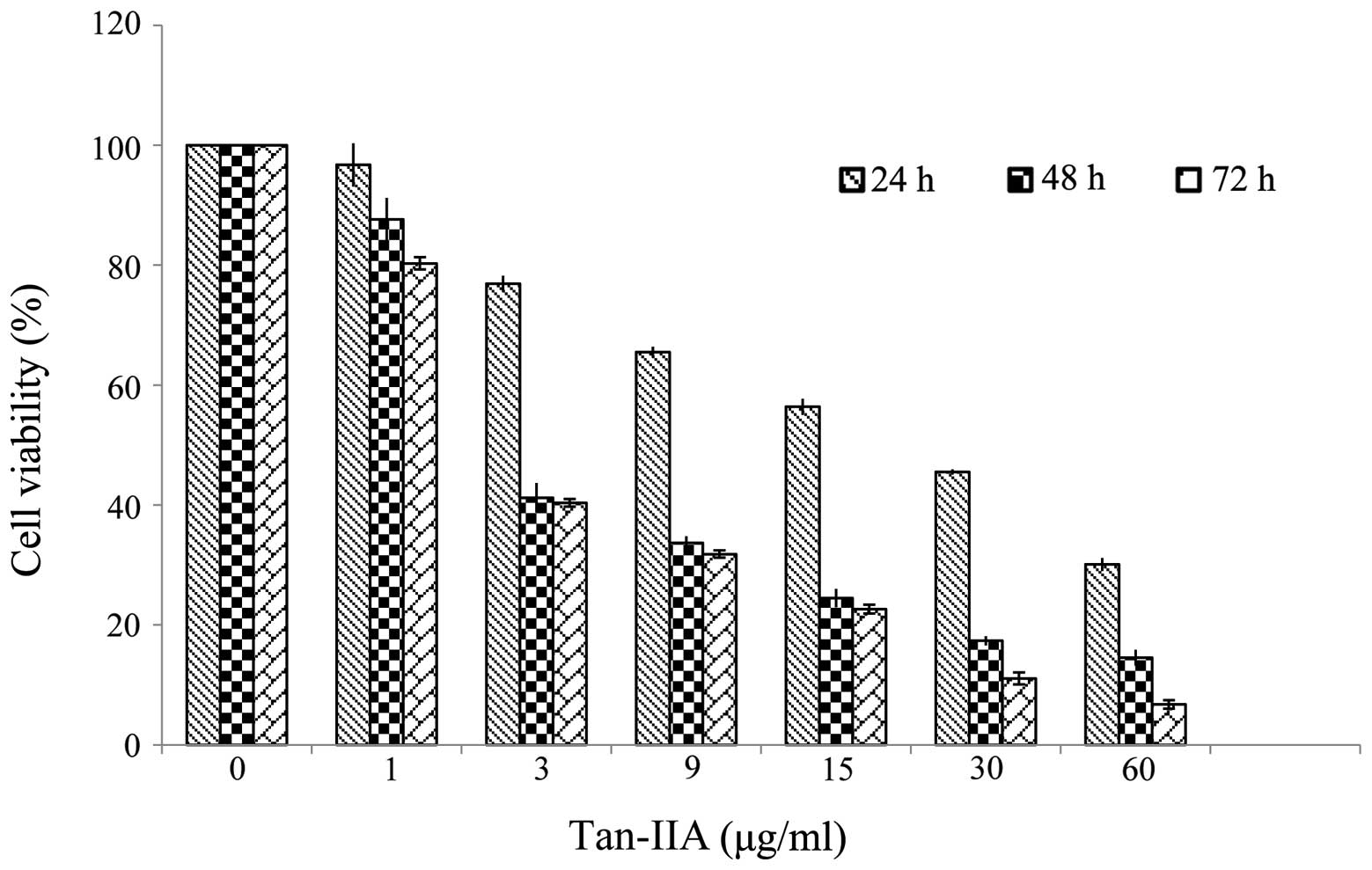 |
Figure 1
|
 |
Figure 2
|
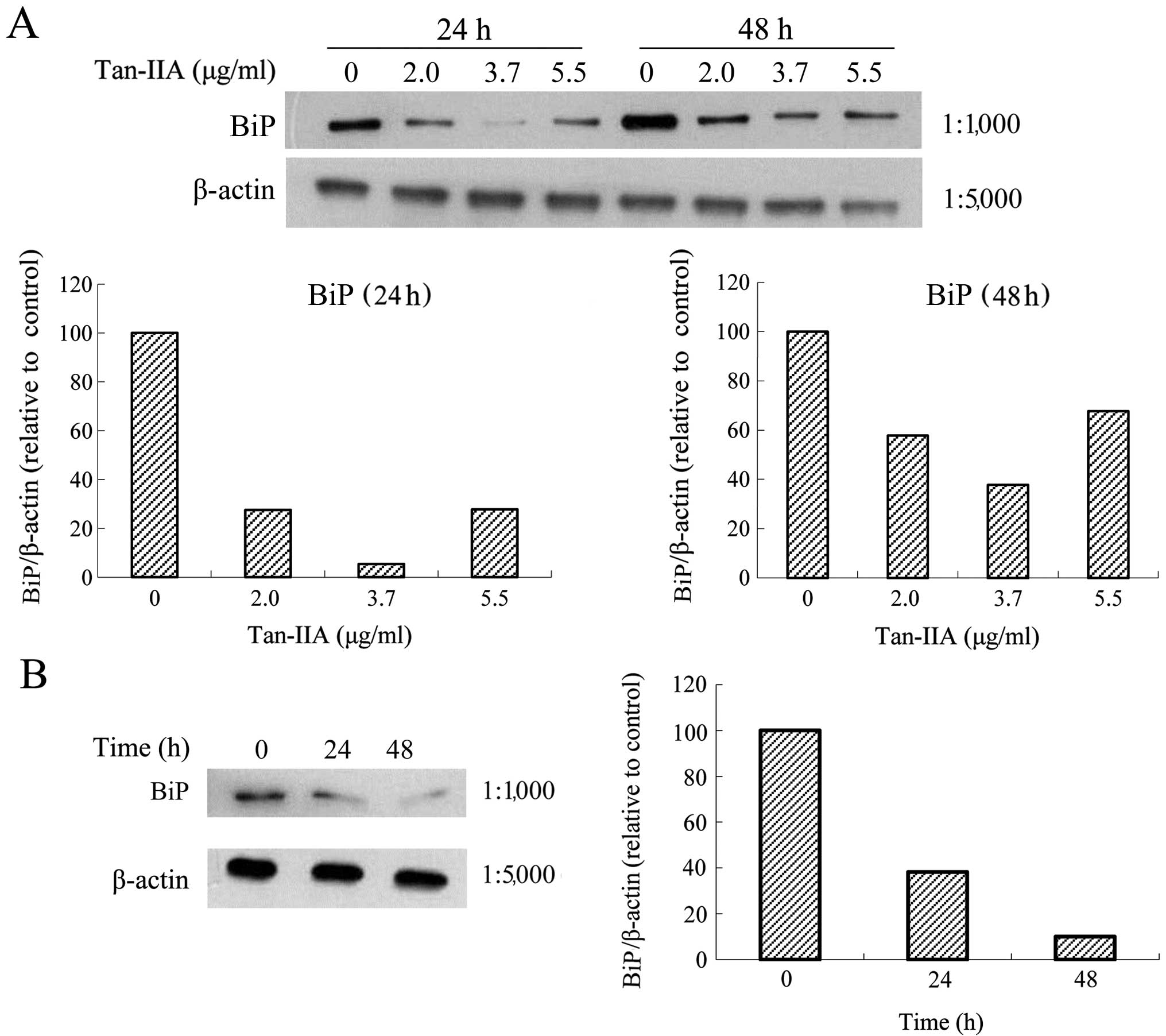 |
Figure 3
|
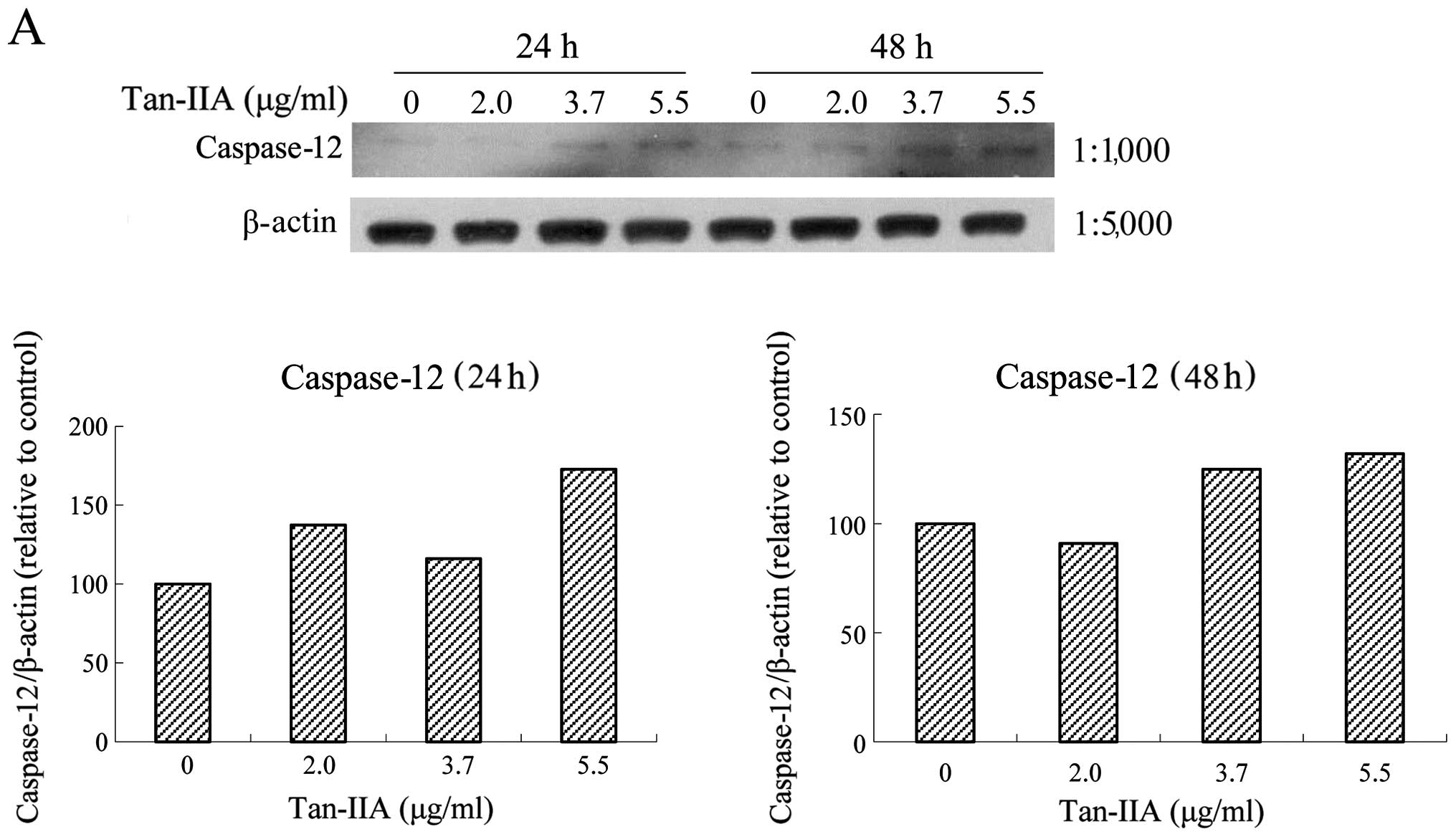 |
Figure 4
|
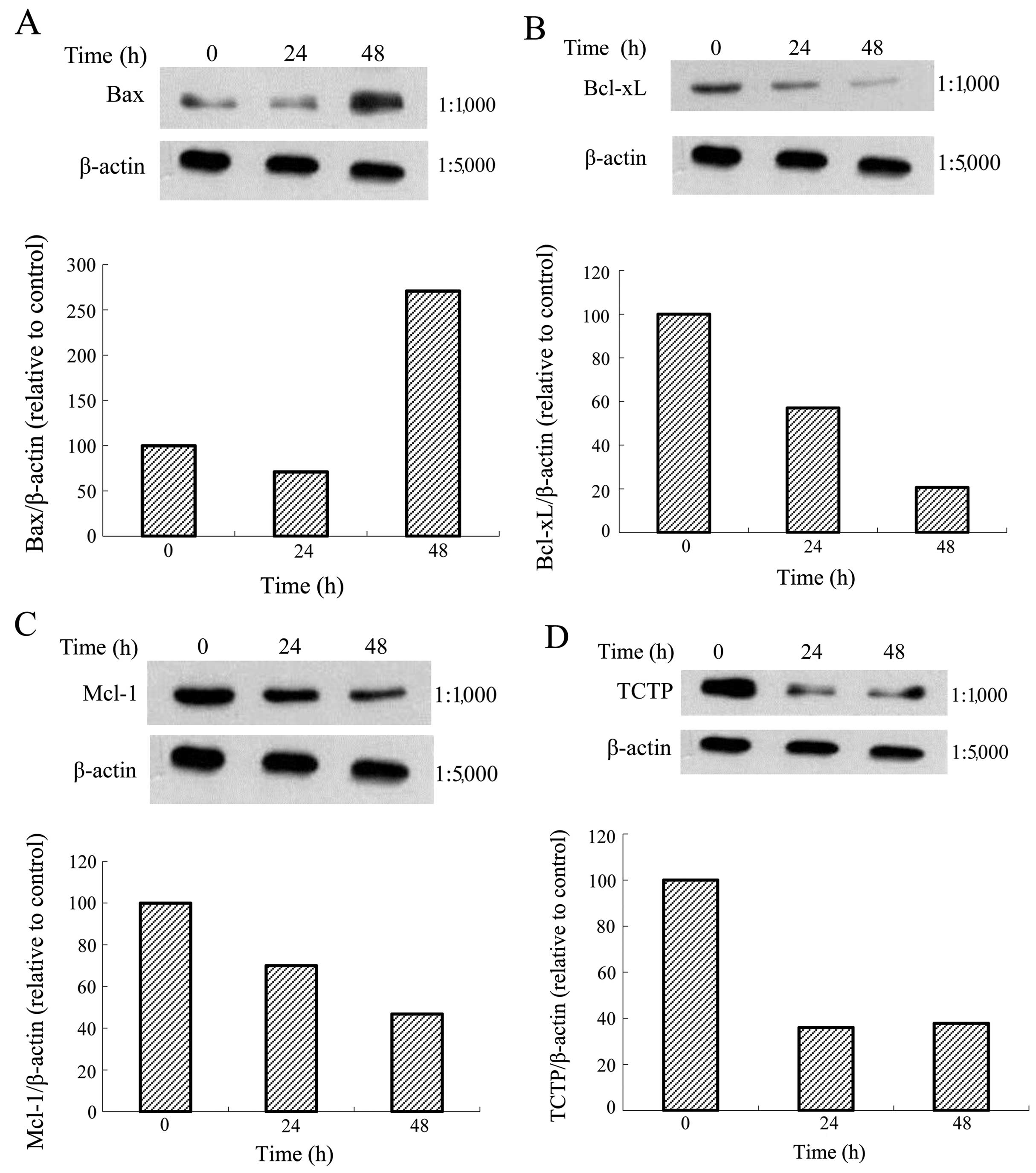 |
Figure 5
|
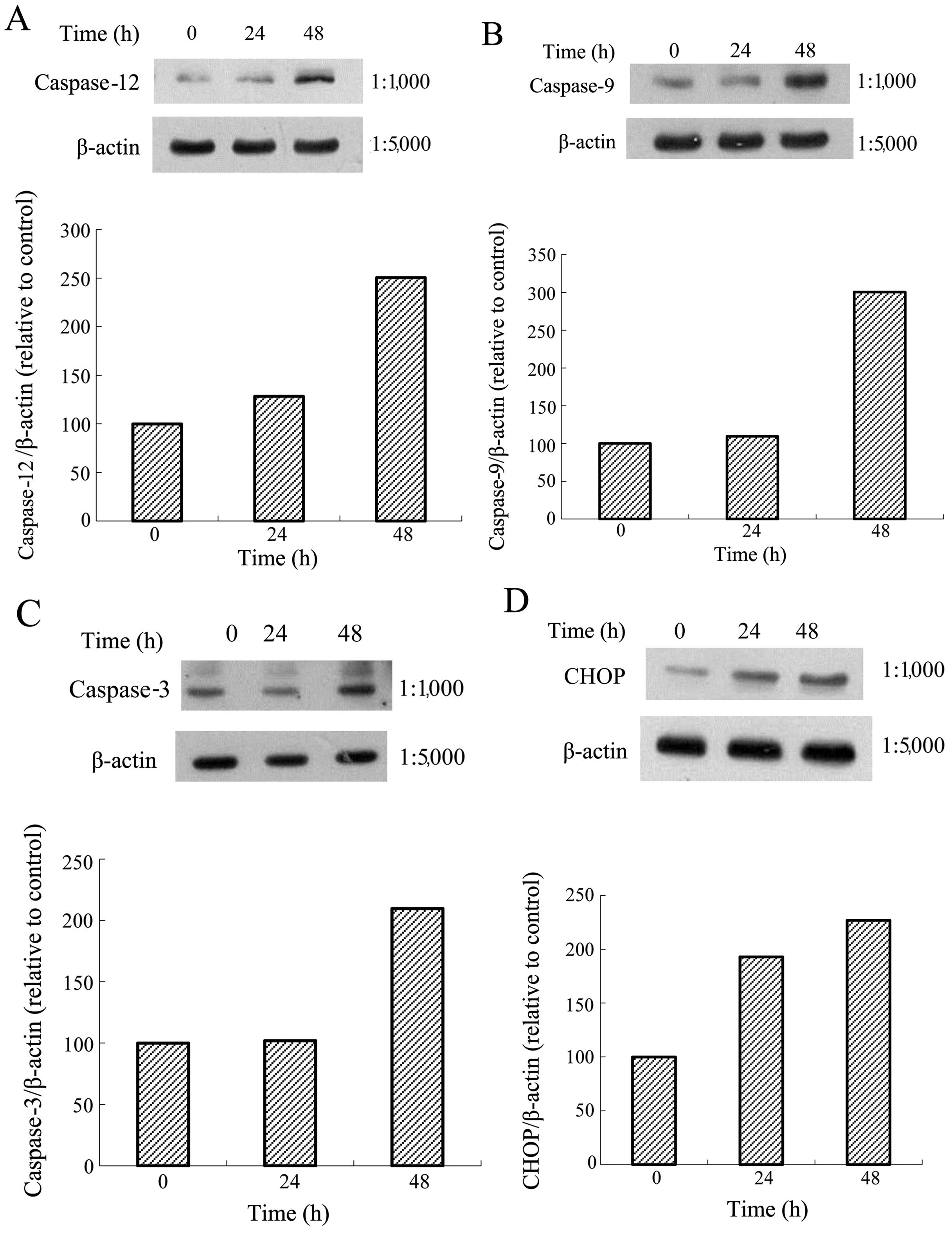 |
Figure 6
|
 |
Figure 7
|
View References
|
1
|
Che AJ, Zhang JY, Li CH, Chen XF, Hu ZD
and Chen XG: Separation and determination of active components in
Radix Salviae miltiorrhizae and its medicinal preparations
by nonaqueous capillary electrophoresis. J Sep Sci. 27:569–575.
2004.PubMed/NCBI
|
|
2
|
Zhou L, Zuo Z and Chow MS: Danshen: an
overview of its chemistry, pharmacology, pharmacokinetics, and
clinical use. J Clin Pharmacol. 45:1345–1359. 2005. View Article : Google Scholar : PubMed/NCBI
|
|
3
|
Chiu TL and Su CC: Tanshinone IIA induces
apoptosis in human lung cancer A549 cells through the induction of
reactive oxygen species and decreasing the mitochondrial membrane
potential. Int J Mol Med. 25:231–236. 2010.PubMed/NCBI
|
|
4
|
Su CC, Chen GW, Kang JC and Chan MH:
Growth inhibition and apoptosis induction by tanshinone IIA in
human colon adenocarcinoma cells. Planta Med. 74:1357–1362. 2008.
View Article : Google Scholar : PubMed/NCBI
|
|
5
|
Su CC and Lin YH: Tanshinone IIA inhibits
human breast cancer cells through increased Bax to Bcl-xL ratios.
Int J Mol Med. 22:357–361. 2008.PubMed/NCBI
|
|
6
|
Hou J, He J, Jin X, Hu T and Zhang Y:
Study on optimisation of extraction process of tanshinone IIA and
its mechanism of induction of gastric cancer SGC7901 cell
apoptosis. Afr J Tradit Complement Altern Med. 10:456–458. 2013.
View Article : Google Scholar : PubMed/NCBI
|
|
7
|
Xu M, Cao FL, Li NY, Liu YQ, Li YP and Lv
CL: Tanshinone IIA reverses the malignant phenotype of SGC7901
gastric cancer cells. Asian Pac J Cancer Prev. 14:173–177. 2013.
View Article : Google Scholar : PubMed/NCBI
|
|
8
|
Chen J, Shi DY, Liu SL and Zhong L:
Tanshinone IIA induces growth inhibition and apoptosis in gastric
cancer in vitro and in vivo. Oncol Rep. 27:523–528.
2012.PubMed/NCBI
|
|
9
|
Dong X, Dong J and Peng G:
Growth-inhibiting and apoptosis-inducing effects of Tanshinone II A
on human gastric carcinoma cells. J Huazhong Univ Sci Technolog Med
Sci. 27:706–709. 2007. View Article : Google Scholar : PubMed/NCBI
|
|
10
|
Huang CY, Chiu TL, Kuo SJ, Chien SY, Chen
DR and Su CC: Tanshinone IIA inhibits the growth of pancreatic
cancer BxPC-3 cells by decreasing protein expression of TCTP, MCL-1
and Bcl-xL. Mol Med Rep. 7:1045–1049. 2013.PubMed/NCBI
|
|
11
|
Yan MY, Chien SY, Kuo SJ, Chen DR and Su
CC: Tanshinone IIA inhibits BT-20 human breast cancer cell
proliferation through increasing caspase 12, GADD153 and
phospho-p38 protein expression. Int J Mol Med. 29:855–863.
2012.PubMed/NCBI
|
|
12
|
Cheng CY and Su CC: Tanshinone IIA
inhibits Hep-J5 cells by increasing calreticulin, caspase 12 and
GADD153 protein expression. Int J Mol Med. 26:379–385.
2010.PubMed/NCBI
|
|
13
|
Mossman T: Rapid colorimetric assay for
cellular growth and survival: application to proliferation and
cytotoxicity assays. J Immunol Methods. 65:55–63. 1983. View Article : Google Scholar : PubMed/NCBI
|
|
14
|
Bradford MM: A rapid and sensitive method
for the quantitation of microgram quantities of protein utilizing
the principle of protein-dye binding. Anal Biochem. 72:248–254.
1976. View Article : Google Scholar : PubMed/NCBI
|
|
15
|
Chen HC, Hsieh WT, Chang WC and Chung JG:
Aloe-emodin induced in vitro G2/M arrest of cell cycle in human
promyelocytic leukemia HL-60 cells. Food Chem Toxicol.
42:1251–1257. 2004. View Article : Google Scholar : PubMed/NCBI
|
|
16
|
Yenofsky R, Cereghini S, Krowczynska A and
Brawerman G: Regulation of mRNA utilization in mouse
erythroleukemia cells induced to differentiate by exposure to
dimethyl sulfoxide. Mol Cell Biol. 3:1197–1203. 1983.PubMed/NCBI
|
|
17
|
Bommer UA, Lazaris-Karatzas A, De
Benedetti A, et al: Translational regulation of the mammalian
growth-related protein P23: involvement of eIF-4E. Cell Mol Biol
Res. 40:633–641. 1994.PubMed/NCBI
|
|
18
|
Bommer UA and Thiele BJ: The
translationally controlled tumour protein (TCTP). Int J Biochem
Cell Biol. 36:379–385. 2004. View Article : Google Scholar
|
|
19
|
Susini L, Besse S, Duflaut D, et al: TCTP
protects from apoptotic cell death by antagonizing bax function.
Cell Death Differ. 15:1211–1220. 2008. View Article : Google Scholar : PubMed/NCBI
|
|
20
|
Liu H, Peng HW, Cheng YS, Yuan HS and
Yang-Yen HF: Stabilization and enhancement of the antiapoptotic
activity of mcl-1 by TCTP. Mol Cell Biol. 25:3117–3126. 2005.
View Article : Google Scholar : PubMed/NCBI
|
|
21
|
Ma Y and Hendershot LM: The role of the
unfolded protein response in tumour development: friend or foe? Nat
Rev Cancer. 4:966–977. 2004. View
Article : Google Scholar : PubMed/NCBI
|





















